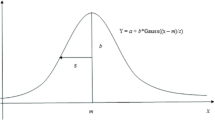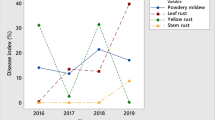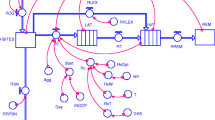Abstract
Surveys have been performed in order to analyze the phenotypic variation in wheat for brown rust resistance, to identify the factors causing the causative agent spread, to adjust the parameter values for assessing the quantitative relationships between the pathogen–host–environment system variables, and to build the imitation model for disease pathogenesis. The highest-level resistance to the disease was typical for the tall wheat plant varieties exhibiting the vertical (less than 15°), deflection (15°–45°), and horizontal (46°–90°) flag-leaf angle patterns; the thick, wax-coating layers (nine scores); the leaf trichome-type indument density of 941.7 ± 63.8 per 1 cm2; and the trichome length of 2.2 ± 0.1 mm. The proposed system of meteopathology forecast models for the brown rust progression was based on the revealed correlations between the pustule numbers, the agent pustule area, the meteorological factors, and the solar activity. The factor model describing the conjugation of the brown rust progression with the spread and effects of the agents causing the mixed infection of leaves has been built based on phytometrics of crop plants, production capacity, meteorological factors, and solar activities with the use of the Leningradskaya-6 cultivar. It can provide the opportunity to carry out a system analysis of changes in the indicated parameter values relative to the environmental factors. Thus, it was revealed based on the model that the brown rust progression rate is increased with increasing the June precipitation amount relative to the number of temperature degrees above 10°C in May. In addition, the increased rates of wheat flag-leaf damage caused by septoria and powdery mildew tend to limit the progression of brown rust. The imitation model for the wheat brown rust progression is based on the solving system of delay differential equations (DDE) with numerical routines from the DIFSUBDEL software package. The model may be used to create modern expert systems for plant disease forecasting and diagnosing.



Similar content being viewed by others
REFERENCES
Arkhipov, M.V., Tyukalov, Y., Danilova, T., et al., Managed grain production as an element of rational nature management, ensuring the production of economically valuable grain with a minimum level of hidden damage, Agriculture Digitalization and Organic Production. “Smart Innovation, Systems and Technologies,” Singapore: Springer-Verlag, 2022, pp. 103–112. https://doi.org/10.1007/978-981-16-3349-2_9
Pavlyushin, V.A., Vilkova, N.A., Sukhoruchenko, G.I., et al., Fitosanitarnaya destabilizatsiya agroekosistem (Phytosanitary Destabilization of Agroecosystems), St. Petersburg: “Rodnye prostory,” 2013.
Pavlyushin, V.A. and Lysov, A.K., Phytosanitary safety of agro-ecological systems and remote phytosanitary monitoring in plant protection, Sovrem. Probl. Distantsionnogo Zondirovaniya Zemli Kosmosa, 2019, vol. 16, no. 3, pp. 69–78.
Olenin, O.A., Zudilin, S.N., and Osorgin, Yu.V., Digital monitoring of agro-ecosystems indicators based on space and unmanned technologies, Permsk. Agrar. Vestn., 2019, vol. 3, no. 27, pp. 53–61.
Dolzhenko, V.I., Sukhoruchenko, G.I., Burkova, L.A., et al., Improving the range of plant pest control products in Russia in the 21st century, Agrokhimiya, 2021, no. 1, pp. 31–40.
Zhuchenko, A.A., Adaptivnoe rastenievodstvo. Ekologogeneticheskie osnovy. Teoriya i praktika (Adaptive Crop Production. Ecological Bases. Theory and Practice), Moscow: Agrorus, 2008, 2009, vol. 1, vol. 2, vol. 3.
Shishkin, N.V., Derova, T.G., Gul’tyaeva, E.I., et al., Identification of the genes resistant to brown rust in winter soft wheat varieties with the use of conventional and modern research methods, Zernovoe Khoz. Ross., vol. 5, no. 59, 2018, pp. 63–67.
Vilkova, N.A., Nefedova, L.I., and Frolov, A.N., Immunity of seed plants and its phytosanitary value in agroecosystems, Zashch. Karant. Rast., 2015, no. 8, pp. 3–9.
Levitin, M.M., Tanskii, V.I., Vlasov, Yu.I., et al., Principles of the integrated approach to plant protection, Vestn. Zashch. Rast., 1999, no. 1, pp. 44–50.
Chesnokov, Yu.V., Plant resistance to the pathogens, Sel’skokhoz. Biol., 2007, no. 1, pp. 16–35.
Novoselov, S.N., Philosophy of the ideal type of agricultural crops. I. Methodology and method, Nauchn. Zh. Kuban. Gos. Agrar. Univ., 2006, vol. 24, no. 8, pp. 5–27.
Levitin, M.M., Microorganisms and global climate change, Sel’skokhoz. Biol., 2015, vol. 50, no. 5, pp. 641–647.
Siptits, S.O., Romanenko, I.A., and Evdokimova, N.E., Model estimates of climate impact on grain and leguminous crops yield in the regions of Russia, Probl. Prognozirovaniya, 2021, no. 2, pp. 75–86.
Vronskikh, M.D., Correlative link between climate parameters and the level of the development of winter wheat diseases, Agrar. Nauka, 2019, no. 51, pp. 148–153.
Nikolaev, S.V., Zubairova, U.S., Skolotneva, E.S., et al., A system approach to the modeling of fungal infections of the wheat leaf, Vavilovskii Zh. Genet. Sel., 2019, vol. 23, no. 1, pp. 100-109. https://doi.org/10.18699/VJ19.468
Zharov, V.R., Vasil’ev, S.V., and Semenova, N.N., Metody matematicheskogo modelirovaniya i vychislitel’naya tekhnika v obespechenii issledovanii VIZR, in 70 let VIZR Retrospektiva issledovanii (metodologiya, teoriya, praktika) 1929–1999 (70 years of All-Russian Scientific Research Institute of Plant Protection Research Retrospective (Methodology, Theory, Practice)), St. Petersburg: Innovatsionnyi Tsentr Zashch. Rast. Vseross. Inst. Zashch. Rast., 1999, pp. 88–98.
Gul’tyaeva, E.I., Sibikeev, S.N., Druzhin, A.E., et al., Enlargement of genetic diversity of spring bread wheat resistance to leaf rust (Puccinia triticina Eriks.) in lower Volga region, Sel’skokhoz. Biol., 2020, vol. 55, no. 1, pp. 27–44. https://doi.org/10.15389/agrobiology.2020.1.27rus
Kolesnikov, L.E., Novikova, I.I., Surin, V.G., et al., Estimation of the efficiency of the combined application of chitosan and microbial antagonists for the protection of spring soft wheat from diseases by spectrometric analysis, Appl. Biochem. Microbiol., 2018, vol. 54, no. 5, pp. 546–552.
SILSO, World Data Center—Sunspot Number and Long-term Solar Observations, Royal Observatory of Belgium, On-Line Sunspot Number Catalogue. http://www.sidc.be/SILSO/. Cited October 21, 2021.
“Geophysics”: Average monthly Wolf numbers, “Russian Federal Service for Hydrometeorology and Environmental Monitoring.” http://meteo-dv.ru/geospace/averageMonthW. Cited December 17, 2021.
Kolesnikov, L.E., Uspenskaya, M.V., Kremenevskaya, M.I., et al., Increase in the yield of cereals and decrease in the harmfulness of pathogens when using acrylic hydrogel and protein growth stimulator, Ross. S-kh. Nauka, 2021, no. 3, pp. 33–40.
Merezhko, A.F., Udachin, R.A., Zuev, V.E., et al., Popolnenie, sokhranenie v zhivom vide i izuchenie mirovoi kollektsii pshenitsy, egilopsa i tritikale: metodicheskie ukazaniya (Replenishment, Live Preservation and Study of the World Collection of Wheat, Aegilops and Triticale: Guidelines), St. Petersburg: Vses. Nauchno-Issled. Inst. Rastenievod. im. N.I. Vavlilova, 1999, pp. 32–50.
Ionova, N.E., Khokhlova, P.N., Valiullina, R.N., et al., The role of individual organs in the production process in spring wheat plants of different ecological and geographical origin, Sel’skokhoz. Biol., 2009, no. 1, pp. 60–67.
Gregori, P., Spread of phytopathogenic microorganisms through the air, Sel’sk. Khoz. Rubezhom. Rastenievod., 1964, no. 2, pp. 53–58.
Sanin, S.S., Current phytosanitary problems in Russia, Izv. Timiryazevsk. S-kh. Akad., 2016, no. 6, pp. 45–50.
Canin, S.S., Protection of wheat from leaf rust, Zashch. Karant. Rast., 2007, no. 11, p. 58.
Rihan, F.A., Delay Differential Equations and Applications to Biology, Singapore: Springer-Verlag, 2021. https://doi.org/10.1007/978-981-16-0626-7
Zheltkov, D.A., Tret’yakova, R.M., Zheltkova, V.V., et al., An efficient software implementation of numerical methods for solving stiff systems of delay differential equations, Vychisl. Metody Program., 2020, vol. 21, pp. 78–86.
Temirbekova, S.K., Kulikov, I.M., Afanas’eva, Yu.V., et al., Parent material of winter wheat for selection of varieties resistant to stress factors, Vestn. Ross. S-kh. Nauki, 2021, no. 1, pp. 16–24.
Chekmarev, V.V., Novyi podkhod k sostavleniyu formul prognoza boleznei sel’skokhozyaistvennykh kul’tur (na primere rzhavchinnykh zabolevanii zernovykh kul’tur) (A New Approach to Compiling Formulas for Predicting Diseases of Agricultural Crops (the Case of Rust Diseases of Grain Crops)), Tambov: Print-Servis, 2016.
Medinets, O.E., Environmental prerequisites for epiphytoties of brown rust of wheat, 2014, no. 7, pp. 12–25.
Funding
The survey is performed within the applied science research theme of the RF Ministry of Agriculture: Modeling the impacts of agroecological factors on spreading the crop disease agents to assess wheat yield potential under changing environmental conditions in the Northwest of the Russian Federation. This corresponds to the state task relative to the VIR thematic plan for project no. 0662-2019-0006: Finding the Cereal Crops, Maintaining Their Viability, and Unlocking the Potential for Genetic Variation in Them for the VIR World Seed Collection to Develop the Genebank Facilities Optimal for Rational Use in Plant Breeding and Agriculture.
Author information
Authors and Affiliations
Corresponding authors
Ethics declarations
This article does not contain any studies involving animals or human participants performed by any of the authors.
Additional information
Translated by O. Zhiryakova
About this article
Cite this article
Kolesnikov, L.E., Kolesnikov, E.K., Pavlyushin, V.A. et al. Phenotypic Expression of Brown Rust Resistance in Wheat: Element Modeling. Russ. Agricult. Sci. 48, 103–114 (2022). https://doi.org/10.3103/S1068367422020082
Received:
Revised:
Accepted:
Published:
Issue Date:
DOI: https://doi.org/10.3103/S1068367422020082




